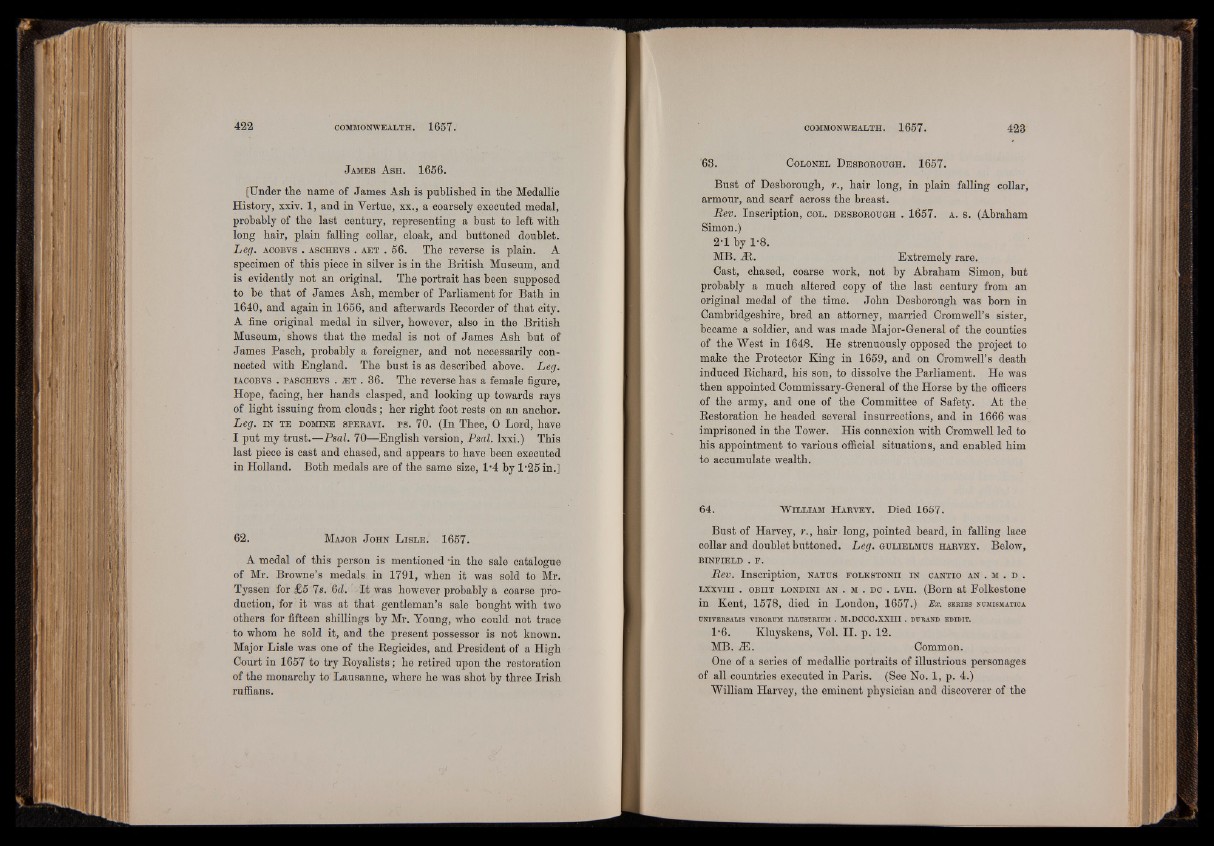
J am e s A s h . 1656.
[Under the name of James Ash is published in the Medallic
History, xxiv. 1, and in Vertue, xx., a coarsely executed medal,
probably of the last century, representing a bust to left with
long hair, plain falling collar, cloak, and buttoned doublet.
Leg. acobys . a sc h ev s . a e t . 56. The reverse is plain. A
specimen of this piece in silver is in the British Museum, and
is evidently not an original. The portrait has been supposed
to be that of James Ash, member of Parliament for Bath in
1640, and again in 1656, and afterwards Recorder of that city.
A fine original medal in silver, however, also in the British
Museum, shows that the medal is not of James Ash but of
James Pasch, probably a foreigner, and not necessarily connected
with England. The bust is as described above. Leg.
iacobvs . pa sc h ev s . je t . 36. The reverse has a female figure,
Hope, facing, her hands clasped, and looking up towards rays
of light issuing from clouds; her right foot rests on an anchor.
Leg. in t e d om in e speravt. p s . 70. (In Thee, 0 Lord, have
I put my trust.—Psal. 70—English version, Psal. lxxi.) This
last piece is cast and chased, and appears to have been executed
in Holland. Both medals are of the same size, 1‘4 by 1‘25 in.]
62. M a jo r J o h n L i s l e . 1657.
A medal of this person is mentioned ‘in the sale catalogue
of Mr. Browne’s medals in 1791, when it was sold to Mr.
Tyssen for £5 7«. 6d. I t was however probably a coarse production,
for it was at that gentleman’s sale bought with two
others for fifteen shillings by Mr. Young, who could not trace
to whom he sold it, and the present possessor is not known.
Major Lisle was one of the Regicides, and President of a High
Court in 1657 to try Royalists ; he retired upon the restoration
of the monarchy to Lausanne, where he was shot by three Irish
ruffians.
Bust of Desborough, r., hair long, in plain falling collar,
armour, and scarf across the breast.
Rev. Inscription, c o l . d e s b o r o u g h . 1657. a. s . (Abraham
Simon.)
2‘1 by 1-8.
MB. At. Extremely rare.
Cast, chased, coarse work, not by Abraham Simon, but
probably a much altered copy of the last century from an
original medal of the time. John Desborough was born in
Cambridgeshire, bred an attorney, married Cromwell’s sister,
became a soldier, and was made Major-General of the counties
of the West in 1648. He strenuously opposed the project to
make the Protector King in 1659, and on Cromwell’s death
induced Richard, his son, to dissolve the Parliament. He was
then appointed Commissary-General of the Horse by the officers
of the army, and one of the Committee of Safety. At the
Restoration he headed several insurrections, and in 1666 was
imprisoned in the Tower. His connexion with Cromwell led to
his appointment to various official situations, and enabled him
to accumulate wealth.
64. W il l ia m H a r vey . Died 1657.
Bust of Harvey, r., hair long, pointed beard, in falling lace
collar and doublet buttoned. Leg. g u l ie lm u s h a rv ey . Below,
BINFIELD . F.
Rev. Inscription, n a t u s f o l k s t o n i i i n c a n t i o a n . m . d .
Lxxvm . o b i i t l o n d i n i a n . m . d o . l v i i . (Born at Folkestone
in Kent, 1578, died in London, 1657.) Ex. s e b ie 3 n u m ism a t ic a
UNIVERSALIS VIRORUM ILLUSTRIUM . M.DCCC.XXIII . DURAND EDIDIT.
1‘6. Kluyskens, Vol. II. p. 12.
MB. 2E. Common.
One of a series of medallic portraits of illustrious personages
of all countries executed in Paris. (See No. 1, p. 4.)
William Harvey, the eminent physician and discoverer of the